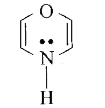Which of the following does not exhibit the periodicity in properties of the elements?
ionisation energy
N/P ratio
electronegativity
atomic radius
The correct Answer is:B
To determine which of the following options does not exhibit periodicity in the properties of elements, we need to analyze the periodic trends of each property mentioned.
1. Understanding Periodicity:
- Periodicity refers to the trends and patterns observed in the properties of elements as you move across a period or down a group in the periodic table. Properties such as ionization energy, electronegativity, and atomic radius show regular trends.
2. Analyzing Ionization Energy:
- Ionization energy generally increases from left to right across a period due to increasing nuclear charge and decreases from top to bottom in a group due to increased distance from the nucleus and electron shielding.
- Conclusion: Ionization energy exhibits periodicity.
3. Analyzing Electronegativity:
- Electronegativity also increases from left to right across a period and decreases from top to bottom in a group, similar to ionization energy.
- Conclusion: Electronegativity exhibits periodicity.
4. Analyzing Atomic Radius:
- Atomic radius decreases from left to right across a period due to increased nuclear charge pulling electrons closer to the nucleus and increases from top to bottom in a group due to the addition of electron shells.
- Conclusion: Atomic radius exhibits periodicity.
5. Analyzing n/p Ratio:
- The n/p ratio (neutron to proton ratio) is influenced by nuclear stability and does not show a regular trend across the periodic table. It can vary significantly without following a predictable pattern.
- Conclusion: The n/p ratio does not exhibit periodicity.
Final Answer:
The property that does not exhibit periodicity in the properties of elements is the n/p ratio.
---
- Periodicity refers to the trends and patterns observed in the properties of elements as you move across a period or down a group in the periodic table. Properties such as ionization energy, electronegativity, and atomic radius show regular trends.
- Ionization energy generally increases from left to right across a period due to increasing nuclear charge and decreases from top to bottom in a group due to increased distance from the nucleus and electron shielding.
- Conclusion: Ionization energy exhibits periodicity.
- Electronegativity also increases from left to right across a period and decreases from top to bottom in a group, similar to ionization energy.
- Conclusion: Electronegativity exhibits periodicity.
- Atomic radius decreases from left to right across a period due to increased nuclear charge pulling electrons closer to the nucleus and increases from top to bottom in a group due to the addition of electron shells.
- Conclusion: Atomic radius exhibits periodicity.
- The n/p ratio (neutron to proton ratio) is influenced by nuclear stability and does not show a regular trend across the periodic table. It can vary significantly without following a predictable pattern.
- Conclusion: The n/p ratio does not exhibit periodicity.
The property that does not exhibit periodicity in the properties of elements is the n/p ratio.
Similar Questions
Knowledge Check
Which of the following compounds would exhibit aromatic properties?
A B
B C
C D
D
Which of the following acids does not exhibit optical isomerism?
AMaleic acidBα-amino acidsCLactic acidDTartaric acidWhich of the following cells does not exhibit phagocytic activity ?
AMonocytesBNeutrophilCBasophilDMacrophage
Which one of the following does not exhibit variable oxidation states?
View SolutionWhich of the following cells does not exhibit phagocytic activity ?
View SolutionWhich one of the following does not exhibit the phenomenon of mutarotation ?
View SolutionWhich of the following cells does not exhibit phagocytic activity ?
View SolutionWhich of the following cells does not exhibit phagocytic activity ?
View Solution
